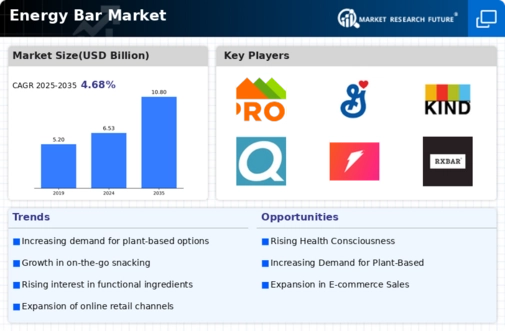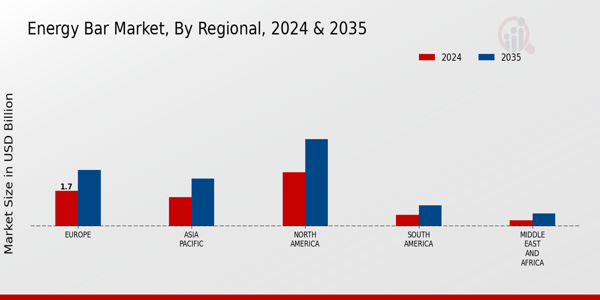Increasing Urbanization
Urbanization is a significant driver of the Global Energy Bar Market Industry, as more people reside in urban areas where fast-paced lifestyles necessitate convenient food options. Energy bars serve as a practical solution for busy urban dwellers seeking nutritious snacks that can be consumed on the go. The growing urban population is expected to enhance the demand for energy bars, aligning with the projected market growth to 10.8 USD Billion by 2035. This demographic shift underscores the importance of convenience and accessibility in food choices, further solidifying the position of energy bars in urban diets.
Market Growth Projections
The Global Energy Bar Market Industry is poised for substantial growth, with projections indicating a market value of 10.8 USD Billion by 2035. This growth trajectory is supported by a compound annual growth rate of 4.68% from 2025 to 2035, reflecting the increasing consumer inclination towards energy bars as a staple snack. The market dynamics are influenced by various factors, including health trends, fitness culture, and urbanization, which collectively contribute to the rising popularity of energy bars. As the industry evolves, it is essential for stakeholders to monitor these trends to capitalize on emerging opportunities.
Rising Health Consciousness
The Global Energy Bar Market Industry is experiencing a notable surge in demand driven by increasing health consciousness among consumers. As individuals become more aware of the importance of nutrition and fitness, they are gravitating towards energy bars as convenient, on-the-go snacks that provide essential nutrients. This trend is reflected in the projected market value of 6.53 USD Billion in 2024, indicating a robust interest in healthier snack alternatives. The appeal of energy bars lies in their ability to offer a balanced mix of proteins, carbohydrates, and vitamins, making them an attractive option for health-focused consumers.
Growth of the Fitness Industry
The Global Energy Bar Market Industry is significantly influenced by the expansion of the fitness sector. As more individuals engage in fitness activities, the demand for energy-boosting snacks has escalated. Energy bars are increasingly marketed to athletes and fitness enthusiasts as a source of quick energy and recovery. The industry's growth is further supported by the anticipated increase in market value to 10.8 USD Billion by 2035. This growth reflects the evolving consumer preferences towards products that align with active lifestyles, thereby solidifying the role of energy bars in the fitness ecosystem.
Innovation in Product Offerings
Innovation plays a crucial role in the Global Energy Bar Market Industry, as manufacturers continuously develop new flavors, ingredients, and formulations to cater to diverse consumer preferences. The introduction of plant-based, gluten-free, and organic energy bars has broadened the market appeal, attracting a wider audience. This trend is likely to contribute to a compound annual growth rate of 4.68% from 2025 to 2035, as consumers seek unique and health-oriented options. The ability of brands to adapt and innovate is essential for maintaining competitiveness in a rapidly evolving market landscape.
Rising Demand for Convenience Foods
The Global Energy Bar Market Industry is benefiting from the rising demand for convenience foods, as consumers increasingly prioritize quick and easy meal solutions. Energy bars fit seamlessly into this trend, offering a portable and nutritious option for individuals with busy schedules. The market's value is projected to reach 6.53 USD Billion in 2024, reflecting the growing preference for snacks that require minimal preparation. This demand for convenience is likely to drive innovation in packaging and marketing strategies, as brands strive to meet the evolving needs of consumers seeking efficiency without compromising on nutrition.





















